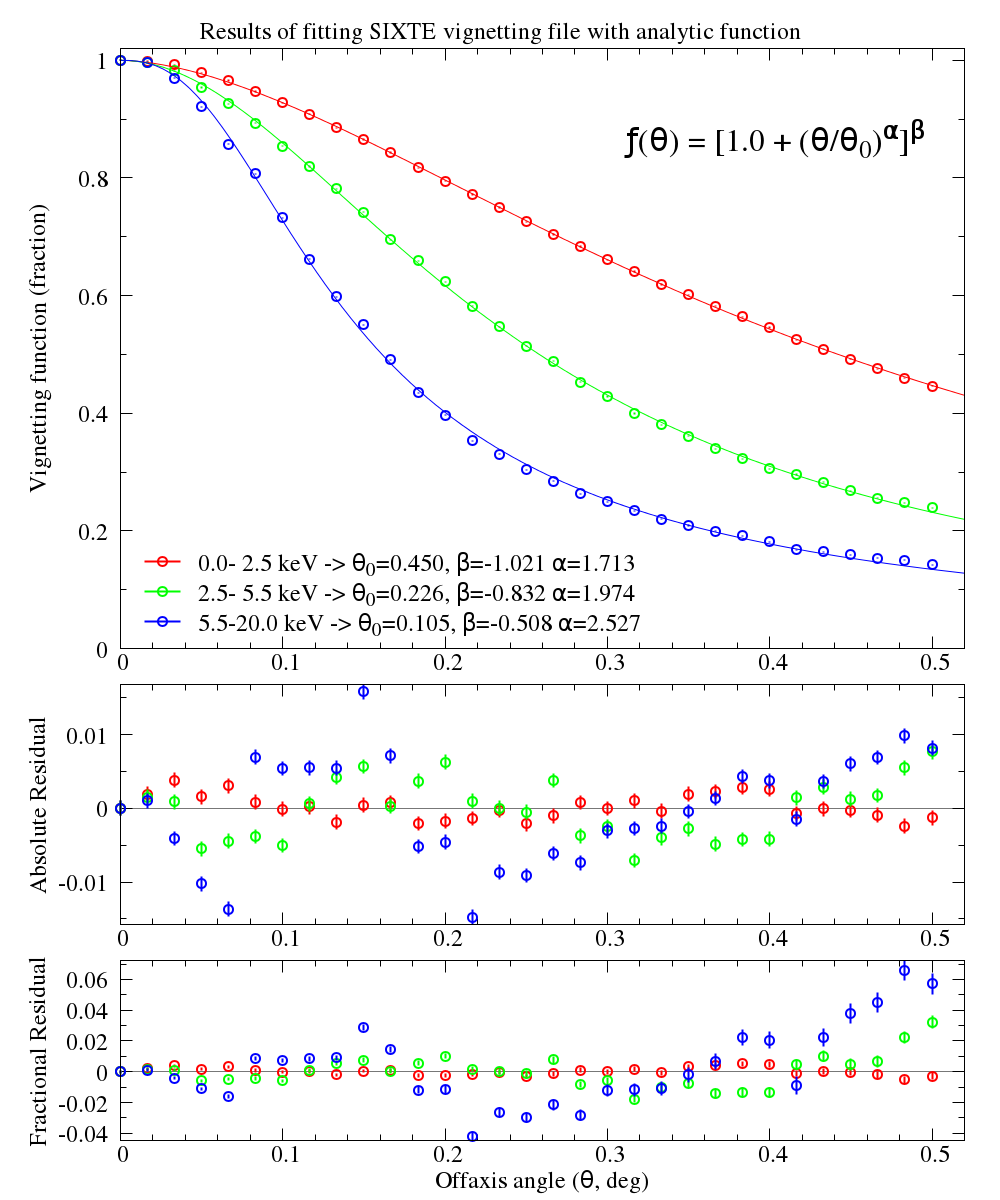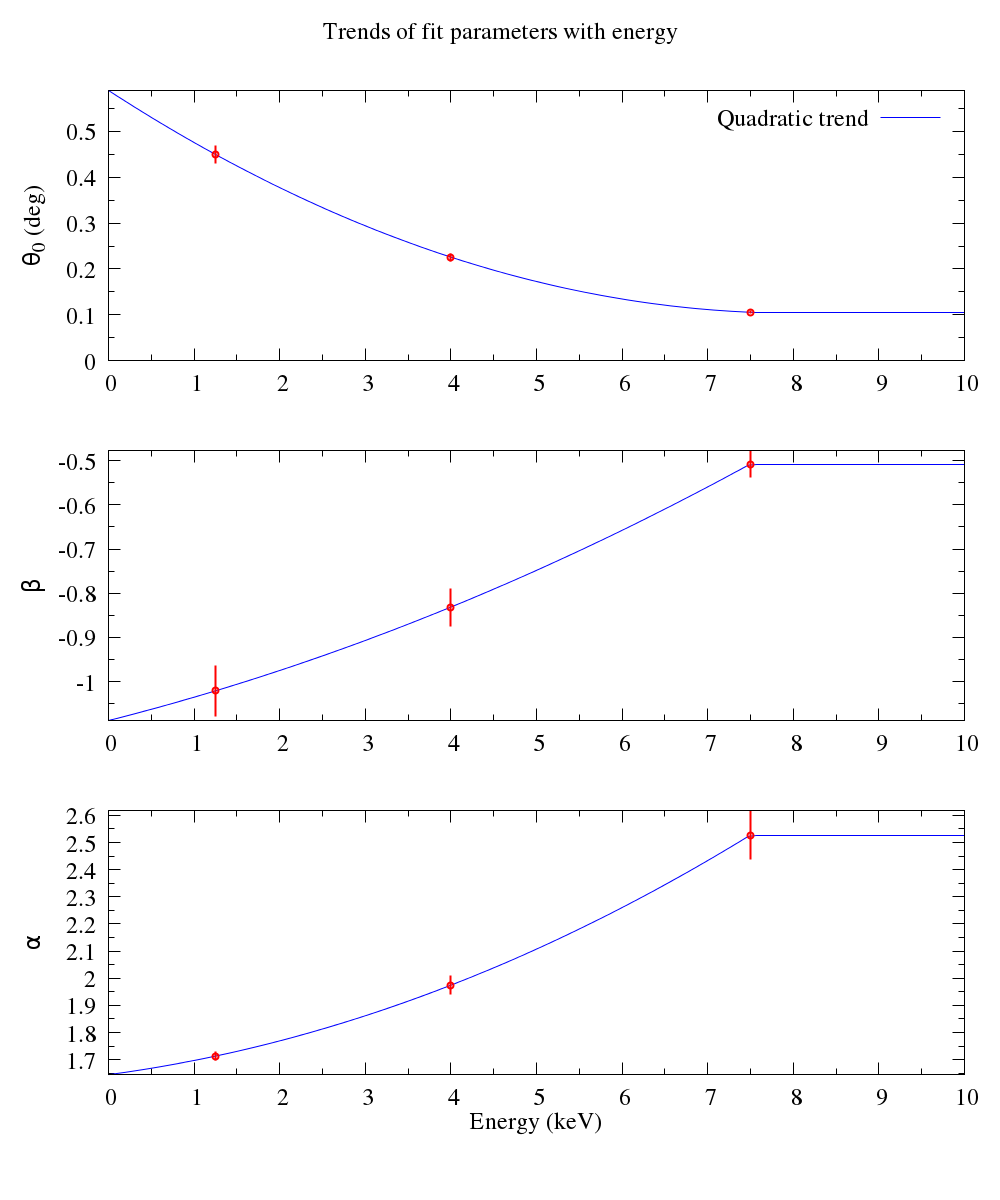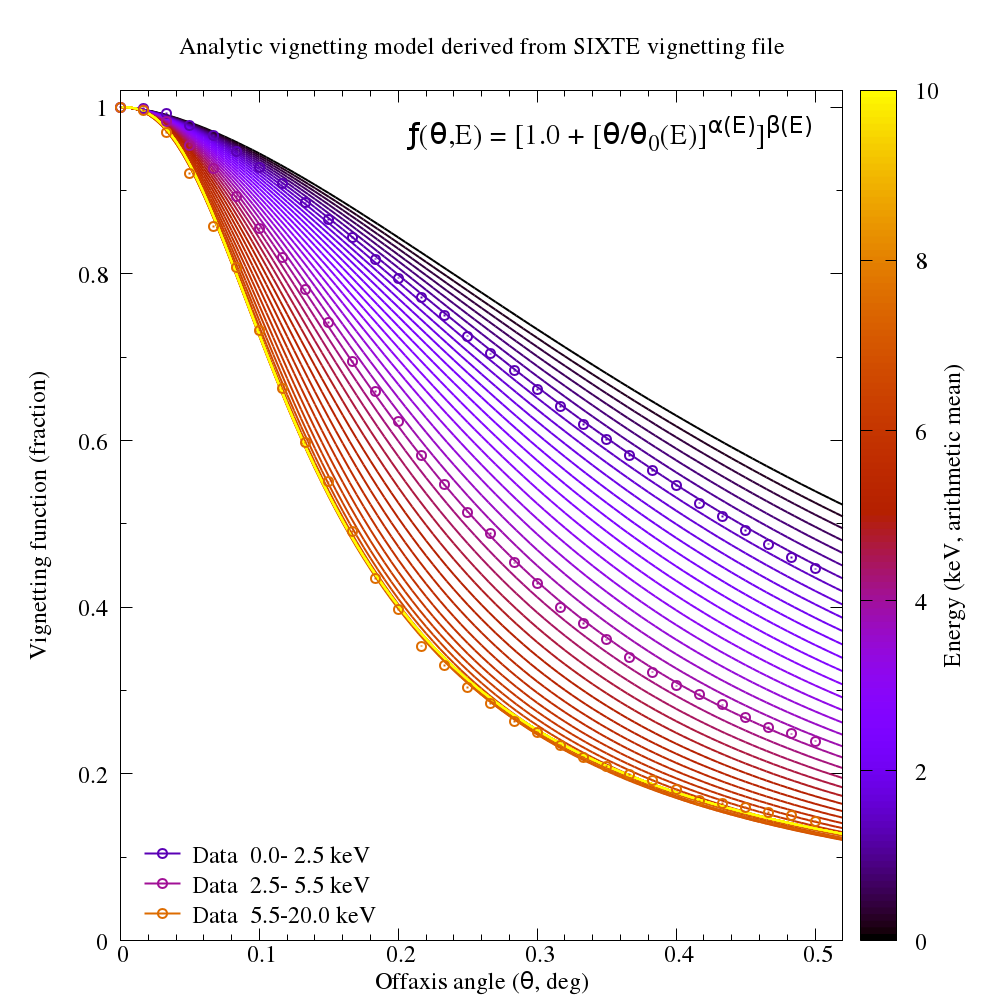|
Size: 5199
Comment:
|
Size: 5653
Comment:
|
| Deletions are marked like this. | Additions are marked like this. |
| Line 7: | Line 7: |
| '''Problem: The current method to represent the eROSITA vignetting function in the eSASS required interpolation from a tabulated grid of calibration measurements, this is computationally awkward, and can lead to discontinuities in the derived system response.''' ''Desired improvement: Compute an analytic description of the vignetting function of each eROSITA telescope module, and save the parameters of this model into the CALDB'' |
* '''Problem: The current method to represent the eROSITA vignetting function in the eSASS required interpolation from a tabulated grid of calibration measurements, this is computationally awkward, and can lead to discontinuities in the derived system response.''' * ''Desired improvement: Compute an analytic description of the vignetting function of each eROSITA telescope module, and save the parameters of this model into the CALDB.'' |
| Line 60: | Line 60: |
| * It is necessary to limit the extrapolation at high energies: {{{ emin = 0.0 emax = 7.5 clip(eraw) = (eraw<emin?emin:(eraw>emax?emax:eraw)) }}} |
|
| Line 67: | Line 61: |
| * We use lagrangian polynomial interpolation ([[https://en.wikipedia.org/wiki/Lagrange_polynomial]]) | * Since we only have three data points in energy, we use Lagrangian polynomial interpolation ([[https://en.wikipedia.org/wiki/Lagrange_polynomial]]) |
| Line 78: | Line 72: |
* It is necessary to limit the extrapolation at high energies: {{{ emin = 0.0 emax = 7.5 clip(eraw) = (eraw<emin?emin:(eraw>emax?emax:eraw)) }}} |
|
| Line 82: | Line 84: |
| * In the future we will have more energy intervals to consider and so a more sophisticated method will be needed to fit the trends of θ,,0,,,β,α as a function of energy | |
| Line 83: | Line 86: |
| * The resultant analytic vignetting model is illustrated in the figure below: | |
| Line 85: | Line 89: |
| Line 91: | Line 96: |
| * File format: * One row per energy band * Columns: Name, FITS format, Units * ENERGY 1E [keV] * COEFFS 3E [degree,-,-] |
Modelling the vignetting function of eROSITA
This is a holding page to gather together notes on producing an analytic vignetting model for eSASS tasks
Problem: The current method to represent the eROSITA vignetting function in the eSASS required interpolation from a tabulated grid of calibration measurements, this is computationally awkward, and can lead to discontinuities in the derived system response.
Desired improvement: Compute an analytic description of the vignetting function of each eROSITA telescope module, and save the parameters of this model into the CALDB.
Zeroth order model (TD)
Input data
- Start from the vignetting description file supplied with the current version of SIXTE
i.e. the file share/sixte/instruments/srg/erosita_vignetting_v2.1.fits supplied in the SIXTE instrument description package v1.4.0
- The file contains a list of vignetting values evaluated for broad energy bands and for many offaxis angles
- The vignetting is tabulated over 3 energy ranges: 0.0-2.5, 2.5-5.5 and 5.5-20 keV, eSASS uses energy ranges: 0.0-2.5, 2.5-5.5 and 5.5-10 keV
- it is not clear what average or effective energy should be assumed for each energy band, for simplicity we assume 1.25keV, 4.5keV and 7.5keV.
- The vignetting is tabulated at 31 off-axis angles (from 0.0-30arcmin) for each energy band
- A single description is used for the vignetting functions of all eROSITA FMs/TMs
Derivation of model parameters
- For each energy value we fit a simple model to the vignetting as a function of off-axis angle (θ)
- For illustrative purposes we assume a uniform 1 sigma uncertainty of 1e-3 per data point
After some trial and error, a distribution of the form: vign(θ) = [1.0 + (θ/θ0)α]β was found to give a reasonable match to the tabulated values
The values of the θ0,β,α parameters are then interpolated using a quadratic expression to allow evaluation of the expression at any energy
- This quadratic form does strange things at energies above the upper tabulated energy band and so the vignetting model is assumed to be constant in energy above 7.5keV
- future versions will be based on more energy bands (five or six?) than the three available here
Figures demonstrating the fit


The parameters describing the model
Results of fits at each energy:
- functional form is:
vign(θ,θ0,β,α) = [1.0 + (θ/θ0)α]β
- where
- θ = off-axis angle in degrees
θ0 is a scaling parameter, also in degrees
- α, β are dimensionless exponents
- independent fits at each of [1.25, 4.0, 7.5] keV give:
Energy= 1.25 keV: theta0= 0.44966 +- 0.02004 beta=-1.02111 +- 0.05693 alpha= 1.71288 +- 0.01767 Energy= 4 keV: theta0= 0.22575 +- 0.00860 beta=-0.83151 +- 0.04289 alpha= 1.97408 +- 0.03523 Energy= 7.5 keV: theta0= 0.10547 +- 0.00350 beta=-0.50753 +- 0.03063 alpha= 2.52732 +- 0.09069
we can describe this as a matrix of coefficients [3 coeffs X Nenergies]
coeff[1,1],coeff[2,1],coeff[3,1] = [ 0.44966, -1.02111, 1.71288] coeff[1,2],coeff[2,2],coeff[3,2] = [ 0.22575, -0.83151, 1.97408] coeff[1,3],coeff[2,3],coeff[3,3] = [ 0.10547, -0.50753, 2.52732]
Since we only have three data points in energy, we use Lagrangian polynomial interpolation (https://en.wikipedia.org/wiki/Lagrange_polynomial)
- i.e if we have three points on the plane at (x1,y1), (x2,y2), (x3,y3), the quadratic equation that passes through all of them is given by:
lagr(x,x1,x2,x3,y1,y2,y3) = y1*((x-x2)/(x1-x2))*((x-x3)/(x1-x3)) + y2*((x-x1)/(x2-x1))*((x-x3)/(x2-x3)) + y3*((x-x1)/(x3-x1))*((x-x2)/(x3-x2))
- Therefore, energy dependent versions of theta0,beta,alpha are given by
f_theta0(energy) = lagr(clip(energy),e[1],e[2],e[3],coeff[1,1],coeff[1,2],coeff[1,3]) f_beta(energy) = lagr(clip(energy),e[1],e[2],e[3],coeff[2,1],coeff[2,2],coeff[2,3]) f_alpha(energy) = lagr(clip(energy),e[1],e[2],e[3],coeff[3,1],coeff[3,2],coeff[3,3])
- It is necessary to limit the extrapolation at high energies:
emin = 0.0 emax = 7.5 clip(eraw) = (eraw<emin?emin:(eraw>emax?emax:eraw))
- And so the general vignetting function is:
vign_gen(oa,energy) = vign(oa,f_theta0(energy),f_beta(energy),f_alpha(energy))
In the future we will have more energy intervals to consider and so a more sophisticated method will be needed to fit the trends of θ0,β,α as a function of energy
- The resultant analytic vignetting model is illustrated in the figure below:

Description of model in CALDB
- See script: "/home/erosita/sw/eSASSdevel/erosita/task/srctool/scripts/build_avign_caldb_files.csh"
- File format:
- One row per energy band
- Columns: Name, FITS format, Units
- ENERGY 1E [keV]
- COEFFS 3E [degree,-,-]
Using the analytic vignetting model in eSASS
- See module eSASS "/home/erosita/sw/eSASSdevel/erosita/task/srctool/srctool_generic_avign_mod.f90"